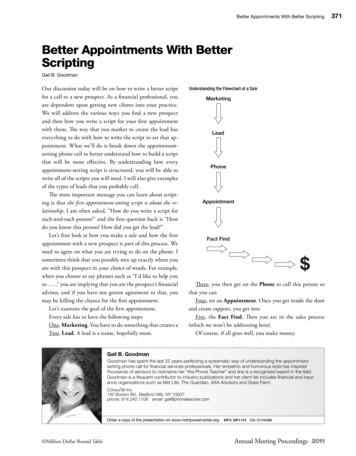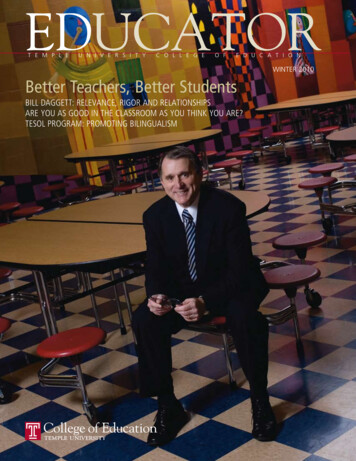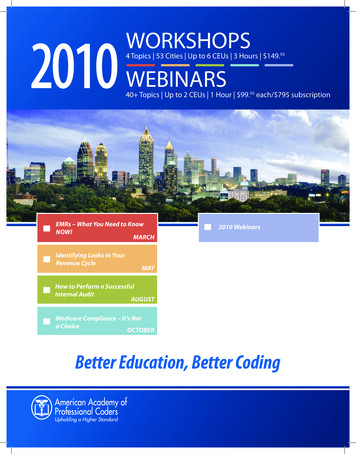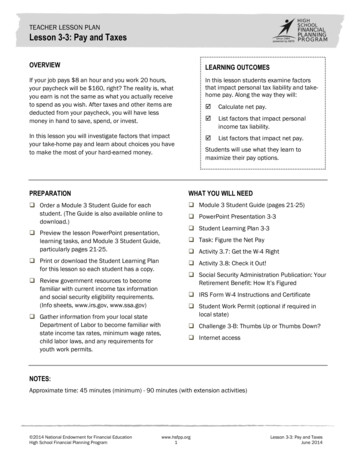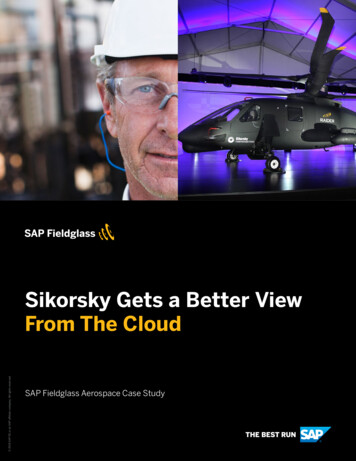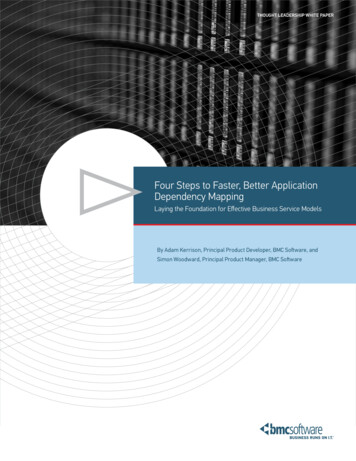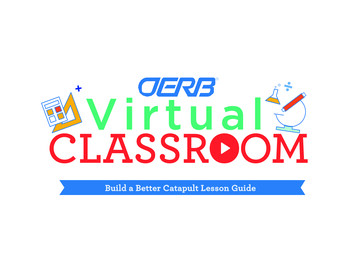
Transcription
Build a Better Catapult Lesson Guide
Lesson Guide DescriptionInstructor: Tina ValentineGrade Level: 3-8Subject: STEMStudents will investigate how potential energy is transformed into kinetic energyusing a simple machine.Wonder Why:Have you ever wondered how to make a catapult? Have youwondered how a catapult works? Have you wondered how toadjust your catapult to launch an object that goes the farthest?Goal:Students will build and test three models of catapults. Studentswill be challenged to build and advertise a “Better Catapult” byusing the Engineering Design Process to design, create, and testtheir own creation.
Lesson Guide Order of Operations and Table of ContentsOrder of Operations and Table of Contents:1.2.3.4.5.6.Build Catapult Model #1: Spoon with a Popsicle BaseBuild Catapult Model #2: Base with a SpoonBuild Catapult Model #3: Square Base with a SpoonTesting Your CatapultsHow it WorksChallenge Yourself!Get ready to catapult yourself into someSTEM fun!
Lesson Guide VocabularyEngineering – the branch of science and technology concerned with the design,building, and use of engines, machines, and structures.Catapult – A catapult is a device or machine used mainly in battles of war to hurl orproject heavy boulders (or explosives) a great distance to fend off enemies, protectforts, or attack enemies.Levers – A lever is a simple machine that allows you to gain a mechanical advantage.It consists of a rigid bar or beam that is allowed to rotate or pivot about a fulcrum,along with an applied force and load.Fulcrum – A fulcrum is the pivot or supporting point of a lever.Potential Energy – Stored energy that depends upon the relative position of variousparts of a system.Elastic Energy – The mechanical potential energy stored in the configuration of amaterial or physical system as it is subjected to elastic deformation by workperformed upon it.Kinetic Energy – Energy which a body possesses by virtue of being in motion.
Lesson Guide Instruction and WorksheetWatch the “Build a Better Catapult” video before continuingto the challenge!Be sure to print and complete your data sheetwhile completing this lesson!If you have any questions throughout this lesson,please email teachers@oerb.com.We would love to hear from you!
Lesson Guide Engineering ProcessEngineering ProcessIdentify the problem and howCommunicate results.IDENTIFYBrainstorm answers tothe problem. Generatelots of ideas. Considerall solutions and selectthe best one.IMAGEARSHINETEST/IMSDEVECollect quantitativeand qualitative dataCompare results withimprovement.NIGPROCREATEBuild the prototypeprocedures.the prototype. Createa list of materials and aprocedure to build theprototype. Discuss thedesired results.
Lesson Guide Materials ListMaterials Needed To Complete All Models:Lots of Popsicle sticksRubber bandsPlastic spoonsCotton balls, pom poms, paper clips, etc. (soft, safe projectiles)TapePaper and pencilTape measureNote: A data sheet is provided on the HomeRoom website. This will help youcollect the data you need to complete the lesson!
Lesson Guide Activity Instruction – Catapult Model #1Catapult Model #1 – Spoon with a Popsicle baseMaterials Needed:9 Popsicle sticks3 Rubber bands1 Spoon
Lesson Guide Activity Instructions – Catapult Model #1Catapult Model #1 Instructions:1.2.3.Take 8 Popsicle sticks and stack them on top of each other. Use arubber band and wrap it around one end of the stack.Insert a single Popsicle stick above the bottom Popsicle so that it isperpendicular. Wrap a rubber band on the other end of the stack of 8.Attach the end of the spoon with a rubber band to the single Popsiclestick so that the spoon rests on top of the stack of 8.Continue to the next page for a visual example
Lesson Guide Activity Instructions – Catapult Model #1
Lesson Guide Activity Instruction – Catapult Model #2Catapult Model #2 – Base with a spoonMaterials Needed:7 Popsicle sticks7 Rubber bands1 SpoonTape
Lesson Guide Activity Instructions – Catapult Model #2Catapult Model #2 Instructions:1.2.3.4.5.Take 3 Popsicle sticks to form a triangle with the sticks crossing overeach other at the endpoints forming an X. Attach a rubber band ateach endpoint X. You need two triangles.Overlay the triangles and attach them together at two points withrubber bands.Where the third points are left open, stretch it apart. You will take asingle Popsicle stick and attach one end of the stick to the lower opentriangle with a rubber band.Stretch apart the other end of the open triangle and attach it alongthe lengths of the single Popsicle stick with a rubber band.Now tape the spoon on the single Popsicle stick.Continue to the next page for a visual example
Lesson Guide Activity Instructions – Catapult Model #2
Lesson Guide Activity Instruction – Catapult Model #3Catapult Model #3 – Square Base with a SpoonMaterials Needed:10 Popsicle sticks7 Rubber bands1 SpoonTape
Lesson Guide Activity Instructions – Catapult Model #3Catapult Model #3 Instructions:1.2.3.4.5.Stack 6 Popsicle sticks and use rubber bands to secure both ends.Take a single Popsicle stick and attach it perpendicular to the stackand in the middle of the stack. Secure with a rubber band. Wrap therubber band around the Popsicle stick by crossing the rubber bandaround making X’s as your wrap around.Now to make the square base. Take single Popsicle sticks and attachone at each end of your stack of 6 with rubber bands.Take a single stick and attach to the arm ends to form the square.Tape the end of the spoon to your single stick perpendicular to thestack.Continue to the next page for a visual example
Lesson Guide Activity Instructions – Catapult Model #3
Lesson Guide Testing Your CatapultTesting Your Catapult1.Put your catapult in an open area with a sturdy, flat surface such as a table oran open space on a hard floor.2. Use a tape measure. Tape it down to the floor.3. Place catapult at the starting line.4. Place a cotton ball (or other item – use same items for all models in tests) inthe launching spoon, push the spoon down and let go.5. Record how far the launched item travels. Find where it lands first. (Notbounced or rolled)6. Repeat the test 10 times to make your observations.7. Record results on a data table.8. Repeat for all models.9. Take measurements on a data table (provided) and calculate the total, mean,and furthest distance launched item traveled.10. Make notes on your results.Note: A data sheet is provided on the HomeRoom website. This will help youcollect the data you need to complete the lesson!
Lesson Guide Testing Your CatapultCatapult Testing DataTable Example:Use the Catapult Testing Data Tableprovided on HomeRoom to recordyour data for each Catapult Model!Find the Mean by taking the sum anddividing it by the number of trials:Mean !"# % &'( ") * ,# -./ !0 1/%%/2!"# % 3'(4/0 ") !0 %, 5"(6%/#/2This will allow you to see whichcatapult launched the furthest!
Lesson Guide How it worksHow it Works!Before we challenge ourselves to buildour catapults, let’s check out some of thescience behind how this works!We want to better understand howcatapults work before we launchourselves into building a “better”catapult!
Lesson Guide How it worksThe Science Behind Your Catapult Notice that this is a model of a simple machine, or a lever. We have a Popsiclestick propped up by a fulcrum (a pivoting point). A lever will magnify theforce you put on it if the fulcrum (the pivoting point) is closer to your forcethan it is to the load. The catapult magnifies your force to throw an item.Catapults are levers! The energy is added and stored in the Popsicle stick when the tiny projectilesare added to the spoon. When you let go of the Popsicle stick, the storedenergy is transferred to the object launched by the spoon which then fliesthrough the air. Catapults also use the elastic energy which is transformedinto kinetic energy under tension stored in the rubber bands. The amount offorce is directly related to the amount of mass. If the mass of the projectile is increased, then it requires more force to convertthe stored energy into kinetic energy. The extra force is created by using moreelastic bands. The transferred kinetic energy is the reason the projectile isthrown out of the spoon.
Lesson Guide How it worksThinking and Discussion Questions1.2.3.4.5.6.What happens to the cotton ball? Did it fly? Did it go high or low? Where didit land?What do you expect will happen when you push the spoon farther down?Will this make it fly higher, farther, both higher and farther, or take the samepath but maybe faster?Perform a test: Put your cotton ball in the spoon, push the spoon downfarther, release and observe. You might need to repeat the test a few times tomake your observations. It all happens fast! Does your ball fly higher orlower? Does it land farther or nearer when you push down a lot comparedwith when you push down a little?Did you notice in which case you needed to do the most work? Is it when youpushed down a little or when you pushed down farther?Try more launches. Do you get similar results each time? Is what youobserve what you expected? Can you explain why?Extra: Tell what happens if you move the stack of 6 sticks closer to thelaunching cup or in the other direction. This will change the position of thelaunching stick when the missile becomes airborne. How do you think yourchange will affect the ball’s flight path?
Lesson Guide How it WorksObservations and Results1.Did you see your cotton ball fly higher and farther when you pushed yourlaunching spoon farther down?2.When you bend your spoon, you load your launching spoon up with energy.When you let go, this energy is released and converted to energy of motion.Most of this energy transfers to the missile, which shoots through the air.3.Pushing the spoon down farther takes more effort from you. Maybe you feltyou needed to exert more force or work harder to bend the stick farther.Bending farther means more elastic potential energy gets stored in thespoon, and when you let go, all this potential energy is converted into energyof motion, so the missile flies through the air at a higher speed. In the caseof your catapult, the missile probably flew higher and farther.
Lesson Guide ChallengeChallenge: Use what you have learned to create your own catapult!1.2.3.4.5.6.7.8.Identify your problem: “Build a Better Catapult”Imagine ideas by brainstorming catapult designs: There is limitlessinformation on the internet. We have listed a few resources for you if youneed ideas. With your parent’s permission, go online and see what you canfind.Design your prototype with a sketch or diagram.Create your prototype.Test it and evaluate the solutions.Share your solutions.Redesign if needed.Write an advertisement for your new Prototype Catapult.a. Name your designb. Make a slogan for itc. Include information about your catapult. Give the Who: What: When:Where: Why: and How. Provide other details to “sell” your catapult.
Lesson Guide ChallengeImportant Challenge NoteUse the “Design and AdvertisementWorksheet” provided on HomeRoomto complete this challenge!If you have any questions about thischallenge, please emailteachers@oerb.com.We would love to hear from you!
Lesson Guide Challenge SubmissionWANT TO WIN A PRIZE?Submit your advertisement with a picture of your designand prototype! Share your pictures and advertisementwith us by emailing teachers@oerb.com and onFacebook/Instagram by tagging us @oerbok.Be sure to include your name, grade, school, andteachers!The teacher with the most student submissions will wina 100 Amazon Gift Card!
Lesson Guide Supplemental ResourcesCheck out these additional resources!1. Engineering Processhttps://www.agclassroom.org/ok/resources classroom/engineering.php2. Leonardo Da Vinci’s rdo-da-vinci/
Lesson Guide Oklahoma Academic Standards3.1.R.1 Students will actively listen and speak clearly using appropriate discussionrules.3.R.2 Students will ask and answer questions to seek help, get information, orclarify about information presented orally though text or other media to confirmunderstanding.3.3.W.3 Students will express an opinion about a topic and provide reasons assupport.3.7.W.1 Students will create multimodal content that communicates an idea usingtechnology or appropriate media.3.7.W.2 Students will create presentations using video, photos, and othermultimedia elements to support communication and clarify ideas, thoughs, andfeelings.3.N.2 Add and subtract multi-digit whole numbers, multiple with factors up to 10,represent multiplication and division in various ways; Solve real-world andmathematical problems through the representation of relation operations.3.GM.2.3 Choose an appropriate measurement instrument and measure the lengthof objects to the nearest whole centimeter or meter.3.GM.2.4 Choose an appropriate measurement instrument and measure the lengthof objects to the nearest whole yard, whole foot, or a half inch.3.S.1.1 Summarize and construct a data set with multiple categories using afrequency table, line plot, pictograph, and/or bar graph with scaled intervals.
Lesson Guide Oklahoma Academic Standards3-PS2-1 Students who demonstrate understanding can: Plan and conductinvestigations on the effects of balanced and unbalanced forces on the motion of anobject. Science & Engineering Practices: Planning and carrying out investigations: Planning and carrying out investigations to answer questions or testsolutions to problems in 3-5 builds on K-2 experiences and progresses toinclude investigations that control variables and provide evidence tosupport explanations or design solutions. Plan and conduct an investigation collaboratively to produce data to serveas the basis for evidence, using fair tests in which variables are controlledand the number of trials considered. Crosscutting Concepts: Cause and Effect: Cause and effect relationships are routinely identified.
Lesson Guide Oklahoma Academic Standards3-PS2-2 Students who demonstrate understanding can: Make observations and/ormeasurements of the object’s motion to provide evidence that a pattern can be usedto predict future motion. Science & Engineering Practices: Planning and carrying out investigations: Planning and carrying out investigations to answer questions or testsolutions to problems in 3-5 builds on K-2 experiences and progresses toinclude investigations that control variables and provide evidence tosupport explanations or design solutions. Make observations and/or measurements to produce data to serve as thebasis for evidence for an explanation of a phenomenon or test a designsolution. Crosscutting Concepts: Patterns: Patterns of change can be used to make predictions.
Lesson Guide Oklahoma Academic Standards4.1.R.1 Students will actively listen and speak clearly using appropriate discussionrules.4.1.R.2 Students will ask and answer questions to seek help, get information, orclarify information presented orally through text or other media to confirmunderstanding.4.3.W.3 Students will express an opinion about a topic and provide fact-basedreasons as support.4.7.W.1 Students will create multimodal content that effectively communicates anidea using technology or appropriate media.4.7.W.2 Students will create presentations using videos, photos, and othermultimedia elements to support communication and clarify ideas, thoughts, andfeelings.4.N.1 Solve real-world and mathematical problems using multiplication anddivision4.GM.2.4 Choose an appropriate instrument and measure the length of an object tothe nearest whole centimeter or quarter-inch.4.GM.2.5 Solve problems that dela with measurements of length, when to use liquidvolumes, when to use mass, temperatures above zero and money using addition,subtraction, multiplication, or division as appropriate (customary and metric).4.D.1.2 Use tables, bar graphs, timelines, and Venn diagrams to display data sets.The data may include benchmark or decimals.
Lesson Guide Oklahoma Academic Standards5.1.R.2 Students will ask and answer questions to seek help, get information, orclarify about information presented orally through text or other media to confirmunderstanding.5.1.W.1 Students will give formal and informal presentations in a group orindividually, organizing information and determining appropriate content foraudience.5.2.W.1 Students will create multimodal content that effectively communicates anidea using technology and appropriate media.5.7.W.2 Students will create presentations that integrate visual displays and othermultimedia to enrich the presentation.5.N.1 Divide multi-digit numbers and solve real-world and mathematical problemsusing arithmetic.5.GM.3.2 Choose an appropriate instrument and measure the length of an object tothe nearest whole centimeter or 1/16-inch.5.GM.3.3 Recognize and use the relationship between inches, feet, and yards tomeasure and compare objects.5.GM.3.4 Recognize and use the relationship between millimeters, centimeters, andmeters to measure and compare objects.5.D.1.1 Find the measures of central tendency (mean, median, or mode) and range ofa set of data. Understand that the mean is a “leveling out” or central balance pointof the data.
Lesson Guide Oklahoma Academic Standards6.1.R.2 Students will actively listen and interpret a speaker’s messages (both verbaland nonverbal) and ask questions to clarify the speaker’s purpose and perspective.6.1.W.1 Students will give formal and informal presentations in a group orindividually, organizing information and determining appropriate content andpurpose for audience.6.2.W.1 Students will apply components of a recursive writing process for multiplepurposes to create a focused, organized, and coherent piece of writing.6.3.W.3 Students will clearly state an opinion supported with facts and details.6.7.W.1 Students will create multimodal content that effectively communicatesideas using technologies and appropriate media.6.7.W.2 Students will create presentations that integrate visual displays and othermultimedia to enrich the presentation.6.N.2 Add and subtract integers in order to solve real-world and mathematicalproblems.6.N.4 Multiply and divide decimals, fractions, and mixed numbers; solve realworldand mathematical problems with rational numbers.6.GM.3 Choose appropriate units of measurement and use ratios to convert withinmeasurement systems to solve real-world and mathematical problems.6.D.1 Display and analyze data.6.D.1.1 Calculate the mean, median, and mode for a set of real-world data.
Lesson Guide Oklahoma Academic StandardsMS-PS3-1 Students who demonstrate understanding can: Construct and interpretgraphical displays of data to describe the relationships of kinetic energy to the massof an object and to the speed of an object. Science and Engineering: Analyzing and interpreting data Analyzing data in 6–8 builds on K–5 and progresses to extendingquantitative analysis to investigations, distinguishing between correlationand causation, and basic statistical techniques of data and error analysis. Construct and interpret graphical displays of data to identify linear andnonlinear relationships. Crosscutting Concepts: Scale, Proportion, and Quantity Proportionalrelationships (e.g. speed as the ratio of distance traveled to time taken)among different types of quantities provide information about the magnitude ofproperties and processes.
Lesson Guide Oklahoma Academic StandardsMS-PS3-2 Students who demonstrate understanding can: Develop a model todescribe that when the arrangement of objects interacting at a distance changes,different amounts of potential energy are stored in the system. Science & Engineering Practices Developing and using models Modeling in 6–8 builds on K–5 and progressesto developing, using and revising models to describe, test, and predict moreabstract phenomena and design systems. Develop a model to predict and/or describe phenomena. Crosscutting Concepts: Systems and System Models Models can be used to represent systems and their interactions – such asinputs, processes, and outputs – and energy and matter flows withinsystems.
Lesson Guide Oklahoma Academic Standards7.1.R.2 Students will actively listen and interpret a speaker’s messages (both verbaland nonverbal) and ask questions to clarify the speaker’s purpose and perspective.7.1.W.1 Students will give formal and informal presentations in a group orindividually, providing evidence to support a main idea.7.2.W.1 Students will apply components of a recursive writing process for multiplepurposes to create a focused, organized, and coherent piece of writing.7.3.W.3 Students will introduce a claim and organize reasons and evidence, usingcredible sources.7.7.W.1 Students will select, organize, or create multimodal content to complementand extend meaning for a selected topic.7.7.W.2 Students will utilize multimedia to clarify information and strengthenclaims or evidence.7.N.2.3 Solve real-world and mathematical problems involving addition,subtraction, multiplication and division of rational numbers; use efficient andgeneralizable procedures including but not limited to standard algorithms.7.D.1.1 Design simple experiments, collect data and calculate measures of centraltendency (mean, median, and mode) and spread (range). Use these quantities todraw conclusions about the data collected and make predictions.
Lesson Guide Oklahoma Academic StandardsPA.N.1 Read, write, compare, classify, and represent real numbers and use them tosolve problems in various contexts.PA.D.1 Display and interpret data in a variety of ways, including using scatterplotsand approximate lines of best fit. Use line of best fit and average rate of change tomake predictions and draw conclusions about data.A1.A.1.1 Use knowledge of solving equations with rational values to represent andsolve mathematical and real-world problems (e.g., angle measures, geometricformulas, science, or statistics) and interpret the solutions in the original context.A1.D.1 Display, describe, and compare data. For linear relationships, makepredictions and assess the reliability of those predictions
Lesson Guide Oklahoma Academic Standards8.1.R.2 Students will actively listen and interpret a speaker’s messages (both verbaland nonverbal) and ask questions to clarify the speaker’s purpose and perspective.8.1.W.1 Students will give formal and informal presentations in a group orindividually, providing textual and visual evidence to support a main idea.8.2.W.1 Students will apply components of a recursive writing process for multiplepurposes to create a focused, organized, and coherent piece of writing.8.3.W.3 Students will introduce a claim, recognize at least one claim from anopposing viewpoint, and organize reasons and evidences, using credible sources.8.7.W.1 Students will select, organize, or create multimodal content thatencompasses different points of view.8.7.W.2 Students will utilize multimedia to clarify information and emphasizesalient points.
Lesson Guide Oklahoma Academic StandardsPA.N.1 Read, write, compare, classify, and represent real numbers and use them tosolve problems in various contexts.PA.D.1 Display and interpret data in a variety of ways, including using scatterplotsand approximate lines of best fit. Use line of best fit and average rate of change tomake predictions and draw conclusions about data.A1.A.1.1 Use knowledge of solving equations with rational values to represent andsolve mathematical and real-world problems (e.g., angle measures, geometricformulas, science, or statistics) and interpret the solutions in the original context.A1.D.1 Display, describe, and compare data. For linear relationships, makepredictions and assess the reliability of those predictions.
Lesson Guide Oklahoma Academic StandardsMS-PS2-2 Students who demonstrate understanding can: Plan an investigation toprovide evidence that the change in an object’s motion depends on the sum of theforces on the object and the mass of the object. Science & Engineering Practices: Planning and carrying out investigations Planning and carrying out investigations to answer questions or testsolutions to problems in 6–8 builds on K–5 experiences and progresses toinclude investigations that use multiple variables and provide evidence tosupport explanations or design solutions. Plan an investigation individually and collaboratively, and in the design:identify independent and dependent variables and controls, what tools areneeded to do the gathering, how measurements will be recorded, and howmany data are needed to support a claim. Crosscutting Concepts: Stability and Change Explanations of stability and change in natural or designed systems can beconstructed by examining the changes over time and forces at differentscales.If you would like to explore more Oklahoma Academic Standards for Scienceclick here.
3. Now to make the square base. Take single Popsicle sticks and attach one at each end of your stack of 6 with rubber bands. 4. Take a single stick and attach to the arm ends to form the square. 5. Tape the end of the spoon to your single stick perpendicular to
